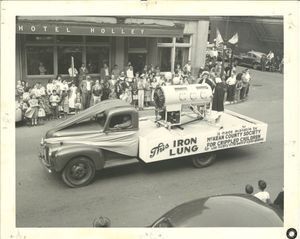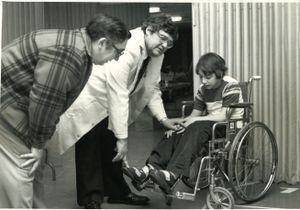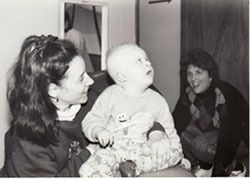Mission and History of CARE for Children
Mission Statement:
CARE for Children is a non-profit organization dedicated to improving the lives of children of all abilities.
Vision Statement:
The realization of an ability-focused culture which helps children cultivate independence, empowers families, and creates a community which fosters the dignity of all.
Core Values:
Inclusion
Building a community which embraces children of all abilities.
Collaboration
Working together as an organization and in our community to support our mission.
Integrity
Unwavering commitment to organizational accountability, best practices and respect for all.
Sustainability
Maintaining organizational stability to meet the evolving needs of the children and families to whom we provide services.
Excellence
Cultivating effective leadership which ensures high quality operations and services that engage, empower and inspire.
DEI Statement:
Inclusion, equity and diversity are central to CARE for Children's organizational culture, and the services we provide. By valuing and respecting differences, abilities and perspectives; and focusing on working together, CARE strives to create a community which fosters the dignity of all.

Seal of Excellence
CARE for Children has been a recipient of the Pennsylvania Association of Nonprofit Organizations’ Seal of Excellence for successfully completing their rigorous Standards for Excellence® accreditation program for 20 years. CARE was first awarded the Seal of Excellence in 2004, and was re-accredited in 2007, 2013, 2017 and most recently in December 2022.
CARE for Children voluntarily opens itself up to analysis by a “jury of its peers.” The peer review team examines CARE for compliance with the Standards for Excellence®: An Ethics and Accountability Code for the Nonprofit Sector, in areas including: Mission, Strategy and Evaluation; Leadership: Board, Staff, and Volunteers; Legal Compliance and Ethics; Finance and Operations; Resource Development; and Public Awareness, Engagement, and Advocacy.
PANO evaluates fundamental values such as honesty, integrity, fairness, respect, trust, responsibility, and accountability, all of which are inherently important in the nonprofit world. CARE’s programs and services, management, fundraising and financial practices were subjected to in-depth examination prior to earning each accreditation.
CARE for Children is the only accredited organization in McKean County.
To see a complete version:
The Standards for Excellence®: An Ethics and Accountability Code for the Nonprofit Sector
Charitable Registration
The official registration and financial information of CARE for Children may be obtained from the Pennsylvania Department of State by calling 1-800-732-0999. Registration does not imply endorsement.
The History of CARE for Children
CARE for Children Celebrates 100 Years of Services for Children
"It is difficult to believe that CARE for Children is celebrating its 100th birthday in 2024. Yet, when seeing the smiles on the children of CARE, year after year, it is easy to see how fast a century can elapse,” according to Tyler R. Hannah, President of the Board of Directors. “Lives are touched on a daily basis, and those days, in turn, add up to years’ worth of therapy, learning and intervention to enrich the lives of those very children and our entire community."
CARE for Children began as an idea that the welfare of children with disabilities should not be left to chance, that an area as large as McKean County should have a formally organized body whose sole purpose was to better the lot of children with disabilities.
In January of 1924, at the request of the Rotary Club of Bradford, the Chamber of Commerce called a joint meeting of civic organizations. In addition to Rotary, the Lions Club, Rotary Club of Kane, Smethport Conupus Club, Bradford Branch of the Commonwealth Humane Society, and the Y’s Men’s Club were all in attendance to discuss a plan to help local “handicapped children.”
In August 1924, the Rotary Club met to undertake a survey of the conditions of children with disabilities; each Rotarian taking a section of the area. 37 children were identified.
In October 1924, area physicians and surgeons along with nurses from Bradford Hospital screened those identified children. Each child was paired with a Rotarian who helped with transportation to the clinic, identified needs, and monitored ongoing treatment.
In November 1924, an orthopedic surgeon traveled from Philadelphia and in the morning hours of clinic saw 20 patients for further treatment. That same afternoon, 9 patients out of the 20 were operated on at the Bradford Hospital with assistance of local physicians and nurses. Children ranged in age from 3 months to 25 years old.

As the efforts to provide clinics, treatment, and follow up, the Rotary Club formed the Crippled Children’s Committee which was based on the guidelines set forth by the Pennsylvania Society for Crippled Children. Rotary also fundraised amongst its members, other clubs and individuals to ensure services were ongoing.
Significantly, these first people to concern themselves with the needs of children with disabilities represented three groups in the county; government, the public schools, and the Rotary Clubs. These same three groups continued to provide most of the guidance, support, and services for children with disabilities in McKean County throughout those early years. At an historic meeting in July 1929, it was decided to proceed with a county-wide society, and that membership in the society should be limited to Rotarians in McKean County. Accordingly, on August 14, 1929, the Society was officially founded. The Society was officially incorporated as a public charity/ membership organization in January of 1930.

The new Society’s only tangible property consisted of a sheet of paper containing the names of 79 children with disabilities who needed help. There was no money in the bank, no office help, no nurse- not even a desk, a file or a typewriter. Nevertheless, at its first meeting in 1930, the new Board of Directors voted to conduct a children’s clinic sometime in the month of January. Operations were on a very modest budget for the first year. Receipts (all from the Bradford and Kane Rotary Clubs) totaled $850.50, while expenditures were $774.17.
Toward the latter part of 1930, it was realized that immediate attention must be given to raising funds. The idea that only Rotarians from Bradford, Kane, Smethport, and Port Allegany should be members of the new organization was soon abandoned, and other civic groups were invited to participate. Individual memberships at $1.00 or more per year were authorized in 1931 and this remained the principle way of raising operating funds.
October 1st, 1930, a full-time nurse was hired to oversee the work of the Society. Her duties included organizing and administering the clinics; ensuring children made it to their assigned hospitals for operations and/or treatment, and making home visits. The headquarters was in the Bradford Supply Company Building at 130 Main Street in Bradford.
Throughout the 1930’s, clinics were held 6-7 times per year. The Society did a lot of fundraising, led by Rotary Clubs, including membership drives. Early efforts to raise money included raffles, entertainment, and home talent shows. The basic membership campaign began to emerge as the primary way of funding the Society’s work. An additional source of income was developed in 1939, when memorial cards were sold, which in their first year netted almost 10% of the total budget.

In the 1940’s, affiliations were established with Zem Zem Hospital (now Shriners Hospital, Erie, PA), Hamot Hospital, Erie PA and Buffalo Children’s Hospital, among others. A Cerebral Palsy School was started in 1946 in the basement of Fourth Ward School with ten children in attendance. In 1949, an equipment loan closet was established to lend wheelchairs, crutches and other equipment to families in need.
In 1949, Lena Graham Griffin was hired as an orthopedic nurse, and in 1950 was named executive secretary. During her leadership at the Society, she witnessed many changes in the treatment of children with disabilities, as it was the era of polio, heavy braces, iron lungs, and segregation in schools and the community. With the emergence of polio in the United States in the late 1940s, the society had its first post- polio clinic in June of 1950. The society began offering speech services at the Cerebral Palsy School in the mid 1950’s. The Smethport Rotary hosted its first Christmas Party for children with disabilities at the Colonial Hotel with 16 children in attendance. During the 1950’s, clinics were at the Bradford Hospital State Room, the Masonic Lodge in Port Allegany and the State Clinic in Kane.
In September 1963, the Society applied for funding through the Bradford United Fund in an effort to support the United Way concept. Just a short time later, the Society was included in the Kane Area United Way, Port Allegany United Fund and Smethport United Way (formerly Smethport Community Chest).
In 1968, the McKean County Society became affiliated with the Pennsylvania Easter Seal Society. With the services, such as an employee pension program, camping programs, educational programs and guidelines available through the State and National organizations, came the responsibility of a name change and meeting standards. The McKean County Society for Crippled Children became the McKean County Easter Seal Society.

In November of 1969, Anna Confer, RN, was hired to replace Mrs. Griffin after her retirement in January of 1970. During the 1960s and 1970s, a swimming program and bowling program were added to the other special events attended by the children in the program. These programs have provided the foundation for CARE’s current therapeutic recreation program.
In the 1970’s, the Nursery School program was moved to The Church of Christ on Derrick Road and clinics were held at the State Room offices on North Bennett Street in Bradford, PA. The organization advocated for community accessibility of curbs and sidewalks and started a special program to provide disabled parking permits for those without a special license plate.
In 1974, the first scoliosis screenings were held at the Bradford Area School District for 7th, 8th, and 9th grade students. 1,064 students were screened and 51 were referred for further evaluation.

In 1985, after 42 years of providing services from the I.O.O.F. Building (now the Seneca Building) the organization relocated to the first floor of 20 School Street and a quarterly newsletter was started. Later in 1986, they made the move to 669 East Main Street (now the site of Valu Home Center Plaza). The space was renovated to make it totally accessible.
In 1988, Rainbow Corner Preschool was formally established and licensed for 30 students through the PA Department of Education.
In November 1991, the organization moved to the Habgood Building owned by the Office of Economic & Community Development where they would lease space for the next 21 years.

In 1994, in order to reduce expenses, Easter Seal created districts within the state instead of maintaining the county relationship. Just prior to this districting project, the McKean County chapter had paid as much as $10,000 in annual dues to Easter Seal which reduced available benefits to the county.
At this point, the McKean County Society elected to disaffiliate with Easter Seal as did many other counties in Pennsylvania. According to the board at the time, “We felt we could not survive this organizational change by Easter Seal. We reverted to our original designation as McKean County Society for Crippled Children.” With the negative connotations of the word “crippled,” it was not an appropriate term to use in the name of such an organization. In the words of one parent, “The word sounds so definite and without hope. This agency gives hope to parents! Your name should reflect that.” The board of directors, with community input, decided on a more positive and upbeat name for the agency. Each letter in the name CARE represented a service: Consultation, Adaptation, Rehabilitation and Education.
Mrs. Confer retired in December 1999 and Ann Ambuske, LCSW, was hired as Executive Director. Under Ambuske’s leadership, the board adopted up-to-date policies and procedures, established a computer system for financial operations and record-keeping, and hired Tina Martin as Community Relations Director to establish a fundraising and development program. Mrs. Ambuske left the organization in January 2002.
In March of 2002, Ann Feightner was named executive director. She, along with the board of directors, spearheaded the adoption of a new mission statement to reflect an active culture of inclusion: CARE for Children is a non-profit organization dedicated to improving the lives of children of all abilities. In 2003, McKean County CARE for Children officially changed its name to CARE for Children to reflect the organization's ever-expanding demographics and to reflect that service is available to children in the surrounding areas. Feightner was instrumental in branding the new name and new mission.
In November 2002, the board of directors and membership of the organization voted to amend both the certificate of incorporation and the bylaws to remove the provisions regarding membership and provide for governance only by the board of directors.
In 2004, Feightner oversaw the organization obtaining the prestigious Seal of Excellence from the Pennsylvania Association from Non-profit Organizations (PANO) Standards for Excellence Program. It was a two-year project in which she led the board and staff in adopting policies, procedures and best practices to meet the rigors of the program. Under Feightner’s direction, Early Intervention Special Instruction (2002); Occupational Therapy (2003); and Family Support Services (2005) were added.
Feightner left CARE in March 2006 and Martin succeeded her as Executive Director.
Some highlights over the past 22 years:
In December 2006, CARE was established as the lead agency for Safe Kids McKean County and undertook establishing a network of child safety and injury prevention programs, countywide.
In 2008, CARE began offering Early Intervention services in Warren County.
In 2009, CARE began offering Early Intervention in Potter County.
In 2012, after 87 years of providing Orthopedic Clinics, with the most recent partnership being Shriners Hospital, Erie PA with Dr. Karl Frankovitch, M.D. attending, the last clinic was held in Bradford. That year the hospital began accepting private insurance and ceased utilizing rural outreach sites.
In 2013, the Ashley Booth Griffin CARE for Children Center, located at 723 East Main Street, Bradford, was dedicated, providing a permanent home for the organization.
In 2013, CARE permanently established Speech and Language Services to its roster of services.
In 2015, CARE hired a licensed social worker to provide services.
In 2019, CARE took over the management of McKean County Cribs for Kids
“Since its inception in 1924, CARE for Children has helped children; and had remarkable growth while remaining completely focused on being mission-driven,” said Karen Gelston, past board president. “CARE has remained true to the idea that the welfare of local children should not be left to chance, honoring the commitment of all those citizens who founded the organization and nurtured its mission of improving the lives of children of all abilities for the last 100 years.”
(Sources: A History of the Crippled Children Society by, R.B. Bromeley; The Bradford Era; The Landmark Society; and CARE for Children)

